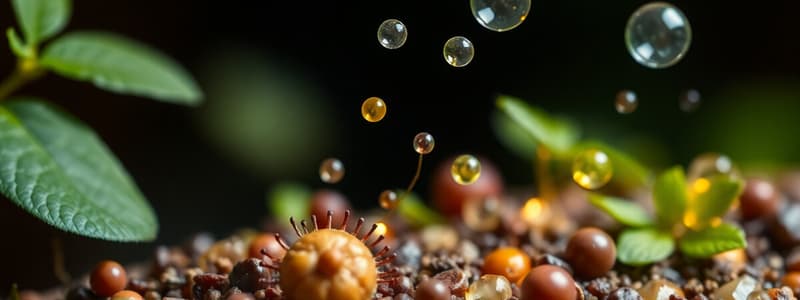Podcast
Questions and Answers
What is the primary distinction between catabolism and anabolism in metabolism?
What is the primary distinction between catabolism and anabolism in metabolism?
- Catabolism involves the production of energy, while anabolism involves breaking down molecules.
- Catabolism refers to breaking down molecules, whereas anabolism is about building up molecules. (correct)
- Catabolism produces biological molecules, while anabolism is only about energy production.
- Catabolism occurs in autotrophs, and anabolism occurs in heterotrophs.
Which of the following correctly defines heterotrophs?
Which of the following correctly defines heterotrophs?
- Organisms that produce their own food using sunlight.
- Organisms that use carbon dioxide as their sole carbon source.
- Organisms that primarily utilize inorganic molecules for energy.
- Organisms that consume organic compounds other than carbon dioxide. (correct)
What characterizes phototrophs in terms of energy sources?
What characterizes phototrophs in terms of energy sources?
- Phototrophs use organic molecules for energy production.
- Phototrophs obtain energy from breaking down inorganic compounds.
- Phototrophs utilize light as their energy source through photosynthesis. (correct)
- Phototrophs rely on chemical reactions to generate energy.
Which of the following statements about chemotrophs is accurate?
Which of the following statements about chemotrophs is accurate?
What type of organisms are considered chemoheterotrophs?
What type of organisms are considered chemoheterotrophs?
What type of organisms are classified as photoautotrophs?
What type of organisms are classified as photoautotrophs?
Which of the following nutrients is essential for synthesizing nucleic acids?
Which of the following nutrients is essential for synthesizing nucleic acids?
Chemoheterotrophs obtain energy and carbon from what sources?
Chemoheterotrophs obtain energy and carbon from what sources?
Organisms require continuous intake of certain nutrients that cannot be synthesized. Which of the following is NOT one of those nutrients?
Organisms require continuous intake of certain nutrients that cannot be synthesized. Which of the following is NOT one of those nutrients?
What determines the nutritional requirements of a microorganism?
What determines the nutritional requirements of a microorganism?
Which element is specifically mentioned as being used in the production of certain co-enzymes?
Which element is specifically mentioned as being used in the production of certain co-enzymes?
What type of energy do chemoautotrophs utilize?
What type of energy do chemoautotrophs utilize?
Which nutrient is NOT typically required by microorganisms?
Which nutrient is NOT typically required by microorganisms?
Which type of fermentation is primarily associated with the production of alcohol?
Which type of fermentation is primarily associated with the production of alcohol?
What is a key product of lactic acid fermentation in humans during intense exercise?
What is a key product of lactic acid fermentation in humans during intense exercise?
Which bacterium is known for producing mixed acids through fermentation?
Which bacterium is known for producing mixed acids through fermentation?
What type of fermentation does Lactobacillus carry out when converting pyruvate?
What type of fermentation does Lactobacillus carry out when converting pyruvate?
Which of the following fermentation processes produces the least specific type of alcohol?
Which of the following fermentation processes produces the least specific type of alcohol?
What is the primary function of ATP in cells?
What is the primary function of ATP in cells?
Which of the following correctly describes ADP?
Which of the following correctly describes ADP?
What role does cyclic AMP (cAMP) play in cells?
What role does cyclic AMP (cAMP) play in cells?
In glycolysis, what is the end product produced from glucose?
In glycolysis, what is the end product produced from glucose?
What is the primary purpose of the Krebs cycle?
What is the primary purpose of the Krebs cycle?
Which of the following sugars can be converted into pyruvate via the glycolytic pathway?
Which of the following sugars can be converted into pyruvate via the glycolytic pathway?
What is the process that occurs after glycolysis in the presence of oxygen?
What is the process that occurs after glycolysis in the presence of oxygen?
What is the relationship between epinephrine and cAMP?
What is the relationship between epinephrine and cAMP?
What are the main products of the Krebs cycle?
What are the main products of the Krebs cycle?
What is the role of NADH and FADH2 in cellular respiration?
What is the role of NADH and FADH2 in cellular respiration?
What happens during deamination in protein metabolism?
What happens during deamination in protein metabolism?
How do bacteria utilize proteins for energy?
How do bacteria utilize proteins for energy?
What occurs in the electron transport chain?
What occurs in the electron transport chain?
Which statement best describes fermentation?
Which statement best describes fermentation?
What is the primary entry point for fatty acids in the Krebs cycle?
What is the primary entry point for fatty acids in the Krebs cycle?
What common process occurs for fats during metabolism?
What common process occurs for fats during metabolism?
Flashcards are hidden until you start studying
Study Notes
Metabolism
- Metabolism is the sum of all chemical reactions that occur in a living organism.
- It includes catabolic reactions (breaking down) and anabolic reactions (building up).
Metabolism - Carbon Sources
- Autotrophs use carbon dioxide as their sole carbon source. Examples include plants, algae, and cyanobacteria.
- Heterotrophs use organic compounds other than carbon dioxide as a source of carbon. Examples include humans, fungi, animals, and protozoans.
- Most microorganisms are chemoheterotrophs utilizing nutrients obtained from hosts, living or dead.
Metabolism - Energy Source
- Phototrophs use light as an energy source.
- Chemotrophs use organic or inorganic molecules as an energy source.
- There are two types of chemotrophs: chemolithotrophs and chemoorganotrophs.
- Chemolithotrophs use inorganic molecules as an energy source.
- Chemoorganotrophs use organic molecules as an energy source.
Carbon + Energy Source Combinations
- Photoautotrophs use light for energy and carbon dioxide for carbon. Examples include plants.
- Photoheterotrophs use light for energy but obtain carbon from organic molecules, a rare form of metabolism.
- Chemoautotrophs use chemicals for energy and carbon dioxide for carbon.
- Chemoheterotrophs use chemicals for energy and obtain carbon from other molecules, like most organisms (excluding plants).
Metabolism: Nutritional Requirements
- Microorganisms need carbon, nitrogen, sulfur, phosphorus, and vitamins.
- They also require sodium, potassium, chlorine, magnesium, calcium, iron, and iodine.
- Organisms need a continuous intake of fatty acids and amino acids, which cannot be synthesized.
- These combine to create the essential macromolecules of life: carbohydrates, amino acids, lipids, proteins, and DNA/RNA.
Metabolism: Energy Source
- Carbon compounds, usually carbohydrates, are the main source of energy for most microbes.
- Nitrogen is used for synthesizing enzymes, proteins, and nucleic acids.
- Sulfur is used in the production of amino acids and co-enzymes.
- Phosphorus is used in the production of nucleic acids and phospholipids.
- Trace elements, like copper, zinc, cobalt, iron, manganese, and selenium, are used as co-factors with enzymes.
- Microorganisms need growth factors, including vitamins that function as co-enzymes.
- They also require amino acids, purines, and pyrimidines.
Metabolism: Nutritional Requirements
- The nutritional requirements of a microorganism are determined by the number and type of enzymes it produces.
- Microorganisms with fewer enzymes need more nutrients because they cannot synthesize the necessary substances.
Catabolic Reactions
- Catabolic reactions result in the release of smaller molecules and energy.
- Examples include:
- 2 H2O(g) 2 H2(g) + O2(g)
- NaCl(s) Na(s) + Cl2(g)
- 602 + C6H1206 → 6C02 + 6H20 + energy
Microbial Metabolism
- Adenosine triphosphate (ATP) is the energy molecule used by cells.
- ATP is produced in the mitochondria (in eukaryotic cells).
- It provides the energy for essential processes like:
- Muscle contractions
- Chromosome movement during cell division
- Active transport
- The production of proteins for enzymes and hormones.
Microbial Metabolism
- Adenosine diphosphate (ADP) is a lower energy compound that is the precursor to ATP.
- During cellular respiration, a phosphate group is added to ADP using a high-energy bond.
- When the cell needs energy, this phosphate group is removed, releasing energy.
- Cyclic AMP (cAMP) is a signaling molecule found inside cells made from ATP.
- It acts as a second messenger, transmitting messages from outside the cell to initiate metabolic activity.
- Epinephrine (adrenaline) is an example of a compound that uses cAMP to start the breakdown of glycogen in the liver.
- Epinephrine increases breakdown without entering the cell.
Glycolysis
- All living cells can convert glucose into pyruvate.
- This process is called glycolysis.
- It takes place in the cytoplasm.
- Some bacteria can convert specific sugars into pyruvate using the glycolytic pathway:
- Mannitol - - Staphylococcus aureus, Enterococcus, and Enterobacter can convert it.
- Glucose
- Lactose
- Sucrose
- The ability to convert these sugars is the basis for biochemical tests used to identify bacteria.
- Mannitol Salt Agar Test – looks for mannitol fermentation and acid production.
- The end result of catabolic processes is the production of pyruvate.
Krebs Cycle
- The Krebs Cycle is also known as the Citric Acid Cycle or Tricarboxylic Acid Cycle.
- After glycolysis, pyruvate is changed to Acetyl-CoA in the presence of oxygen (aerobes), and enters the Krebs Cycle.
- This process occurs in the cytoplasm.
- The Krebs Cycle produces ATP, carbon dioxide gas, and electrons that are transferred to NADH and FADH2 (electron carriers).
Electron Transport Chain (ETC)
- This series of proteins is located in the cell membrane (in the mitochondria in eukaryotes).
- The proteins accept electrons from NADH and FADH2 and pump H+ ions outside the membrane, building an electrochemical gradient.
- H+ ions flow back across the membrane through ATP synthase, a protein.
- As H+ passes through the pump, a phosphate group (Pi) is added to ADP to create ATP.
Protein Metabolism
- Proteins are broken down into amino acids and then deaminated, removing the amine group.
- Ammonia is produced and excreted.
- Some bacteria convert ammonia to urea and use it as an entry point into the TCA cycle.
- Bacteria can use proteins and fatty acids for energy.
- Proteins can be converted into pyruvate which cycles into the Krebs Cycle.
- Proteins can also produce intermediaries from amino acids, such as Acetyl-CoA.
- Deamination removes the amine group from amino acids and produces ammonia.
Fats and Lipids Metabolism
- Fats and Lipids decompose into glycerol and fatty acids.
- Glycerol is converted into pyruvate, which enters the Krebs Cycle through Acetyl-CoA.
- Fatty acids directly enter the Krebs Cycle.
- Bacteria can cycle fats into the TCA cycle.
Fermentation
- Fermentation anaerobically produces low energy, but generates electron acceptors and carriers for ongoing metabolic processes.
- Some bacteria reduce pyruvate to produce energy through fermentation:
- Lactic Acid Fermentation
- Alcohol Fermentation
- 2,3-Butanediol Fermentation
- Mixed Acid Fermentation
Fermentation
- The type of fermentation is determined by the organism's enzymes.
- Lactobacillus converts pyruvate to lactic acid.
- Humans can also convert pyruvate to lactic acid in muscles during strenuous activity.
- Saccharomyces cerevisiae, a fungus, makes alcohol through fermentation.
- Enterobacter produces 2,3-butanediol through fermentation.
- Escherichia coli produces mixed acids.
- All of these processes generate a small amount of ATP.
Metabolism Summary
- Carbohydrates, fats and lipids, and proteins all contribute to the generation of Acetyl-CoA, NADH and FADH2.
- Glycolysis produces pyruvate, which is then converted to Acetyl-CoA that enters the Krebs Cycle.
- The Krebs Cycle utilizes NADH and FADH2, which ultimately provide electrons for the electron transport chain.
- The Electron Transport Chain results in the phosphorylation of ADP to produce ATP.
- Fermentation produces very little energy and is essential for some bacteria to survive in anaerobic environments.
Studying That Suits You
Use AI to generate personalized quizzes and flashcards to suit your learning preferences.




